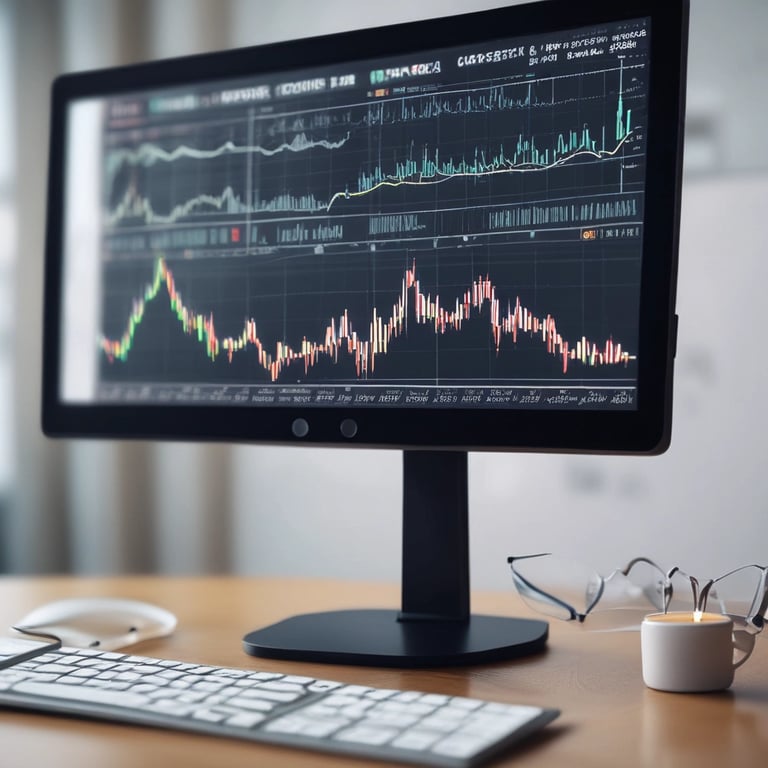What Is Algorithmic Trading and How Does It Work?
1/21/20253 min read


In today’s fast-paced financial markets, trading has evolved significantly from the days of manual execution and gut-based decisions. One of the most transformative advancements in recent decades is algorithmic trading (or algo trading), which leverages computer programs to automate trading activities. But what exactly is algorithmic trading, and how does it work? Let’s dive in.
What Is Algorithmic Trading?
Algorithmic trading is the process of using pre-programmed computer instructions to execute trades. These instructions, also known as algorithms, define specific criteria for making trading decisions, such as timing, price, quantity, and other market-related variables. Once programmed, the algorithm executes trades automatically without the need for manual intervention.
Algo trading is used across asset classes, including stocks, forex, commodities, and cryptocurrencies. For retail traders, one of the most popular tools for engaging in algorithmic trading is the Expert Advisor (EA) on platforms like MetaTrader 4 and MetaTrader 5. These EAs allow traders to automate their strategies easily and trade the markets efficiently.
Key Features of Algorithmic Trading
Automation: Algorithms handle the entire trade lifecycle—from identifying opportunities to execution and settlement.
Speed: Trades can be executed in milliseconds or even microseconds, enabling traders to capitalize on fleeting market opportunities.
Accuracy: Predefined rules reduce human errors in trading.
Scalability: Algo trading can analyze and trade across multiple markets and assets simultaneously.
How Does Algorithmic Trading Work?
Algorithmic trading operates through a series of well-defined steps:
1. Defining the Strategy
The first step is to develop a trading strategy. This could be based on technical indicators, fundamental analysis, statistical models, or machine learning techniques. For example:
Buy a stock when its 50-day moving average crosses above the 200-day moving average (golden cross).
Execute a trade if a specific market news sentiment threshold is met.
For retail traders using MetaTrader platforms, strategies are often coded into Expert Advisors. These EAs can be programmed to follow specific rules and execute trades without manual intervention.
2. Coding the Algorithm
Once the strategy is defined, it is translated into a computer-readable format using programming languages like Python, MQL4, or MQL5 (used for MetaTrader). MetaTrader’s user-friendly interface and large community make it a popular choice for retail traders developing EAs.
3. Backtesting the Strategy
Backtesting involves testing the algorithm on historical market data to evaluate its performance. This step helps refine the strategy and identify potential weaknesses before deploying it in live markets. MetaTrader provides built-in backtesting tools, making it easier for retail traders to assess their EAs.
4. Deploying the Algorithm
After successful backtesting, the algorithm is deployed on a trading platform. For retail traders, this often means activating the Expert Advisor in MetaTrader. The platform connects to the broker’s server, facilitating real-time data access and order execution.
5. Live Execution and Monitoring
Once live, the algorithm continuously monitors the markets and executes trades as per the predefined logic. Traders often set up monitoring systems to track the algorithm’s performance and ensure it operates as intended. MetaTrader provides detailed reports and monitoring tools to assist retail traders in this process.
Common Algorithmic Trading Strategies
Market Making: Algorithms place buy and sell orders simultaneously to profit from the bid-ask spread.
Arbitrage: Exploiting price differences between assets or markets to make risk-free profits.
Trend Following: Algorithms trade based on moving averages, momentum indicators, or other trend-based signals.
Mean Reversion: Buying undervalued assets and selling overvalued ones, assuming prices will revert to the mean.
High-Frequency Trading (HFT): Executing a large number of orders in fractions of a second to exploit tiny price inefficiencies.
Benefits of Algorithmic Trading
Consistency: Algorithms stick to the strategy without succumbing to emotions or bias.
Efficiency: They can analyze vast amounts of data and execute trades faster than human traders.
Cost Reduction: Automation minimizes transaction costs and operational inefficiencies.
Diversification: Algorithms can simultaneously manage multiple strategies across various markets.
For retail traders using MetaTrader, EAs offer a cost-effective and user-friendly entry point into algorithmic trading, eliminating the need for complex setups.
Challenges and Risks
While algorithmic trading offers significant advantages, it is not without challenges:
Technical Glitches: Errors in coding or connectivity issues can lead to losses.
Overfitting: Algorithms tailored too closely to historical data may fail in real-world scenarios.
Regulatory Compliance: Traders must adhere to regulations governing algorithmic trading to avoid legal repercussions.
Market Impact: Large orders executed too quickly can disrupt markets and lead to slippage.
For retail traders, the reliability of the broker and platform (e.g., MetaTrader) is crucial to minimizing these risks.
The Future of Algorithmic Trading
With advancements in artificial intelligence, machine learning, and big data analytics, the scope of algorithmic trading continues to expand. Innovations like predictive analytics, quantum computing, and decentralized trading platforms are expected to shape the future of trading further. For retail traders, the evolution of MetaTrader’s Expert Advisor ecosystem ensures that they can keep pace with these advancements.
Conclusion
Algorithmic trading has revolutionized the way financial markets operate, offering speed, efficiency, and precision. Platforms like MetaTrader have democratized access to algo trading for retail traders through the use of Expert Advisors. However, it’s essential for traders to understand its intricacies, continuously refine their strategies, and remain vigilant against potential pitfalls. As technology evolves, the opportunities in algo trading are bound to grow, making it an exciting field for both seasoned traders and newcomers alike.
Contact Us !
Automate your trading with our expert advisors.
support@xtradingidea.com
© 2025. All rights reserved by xtradingidea.com
